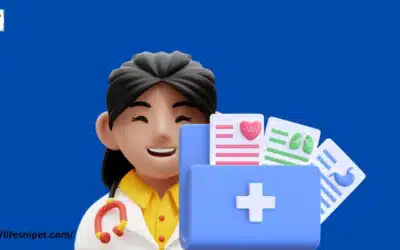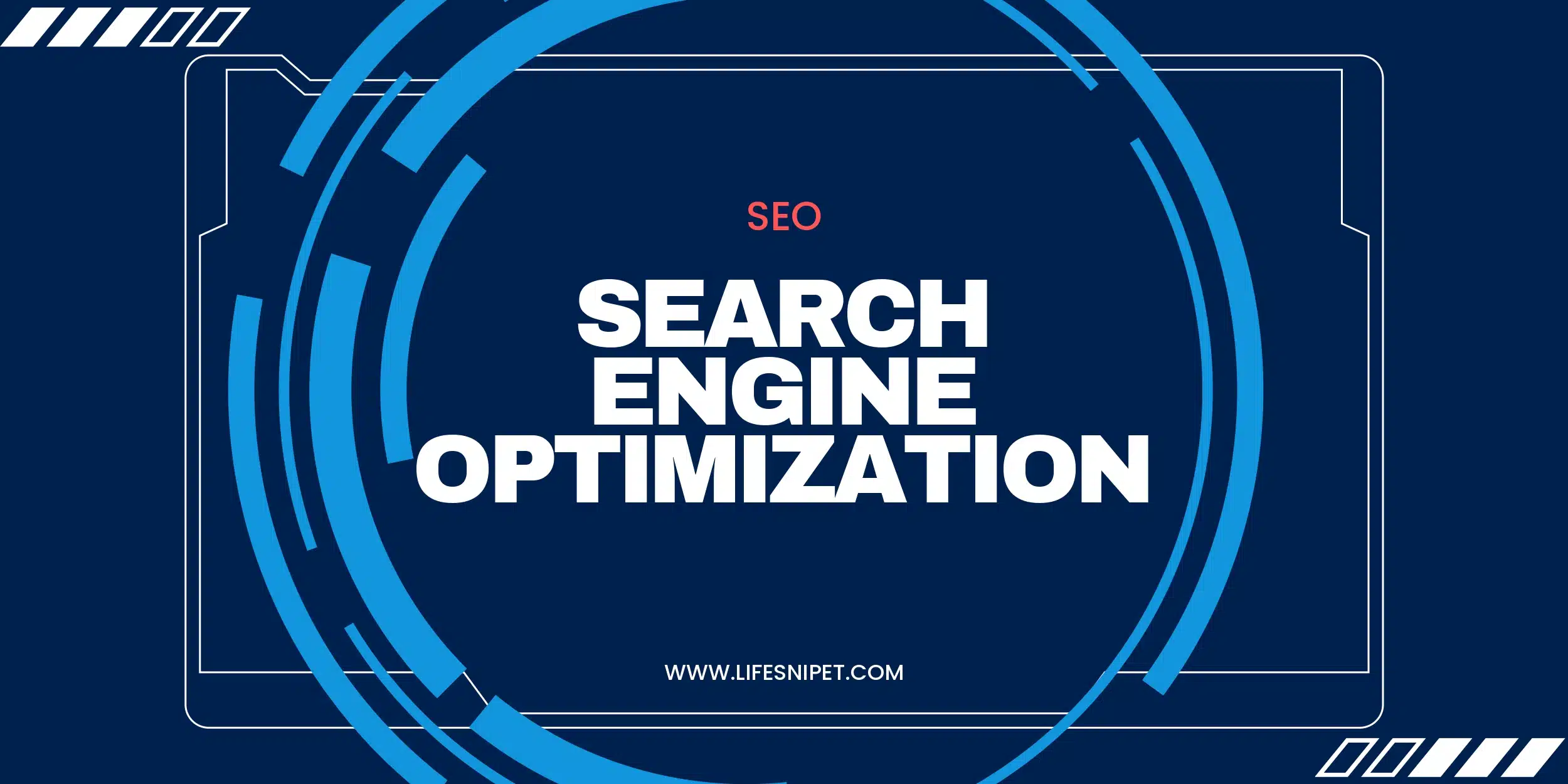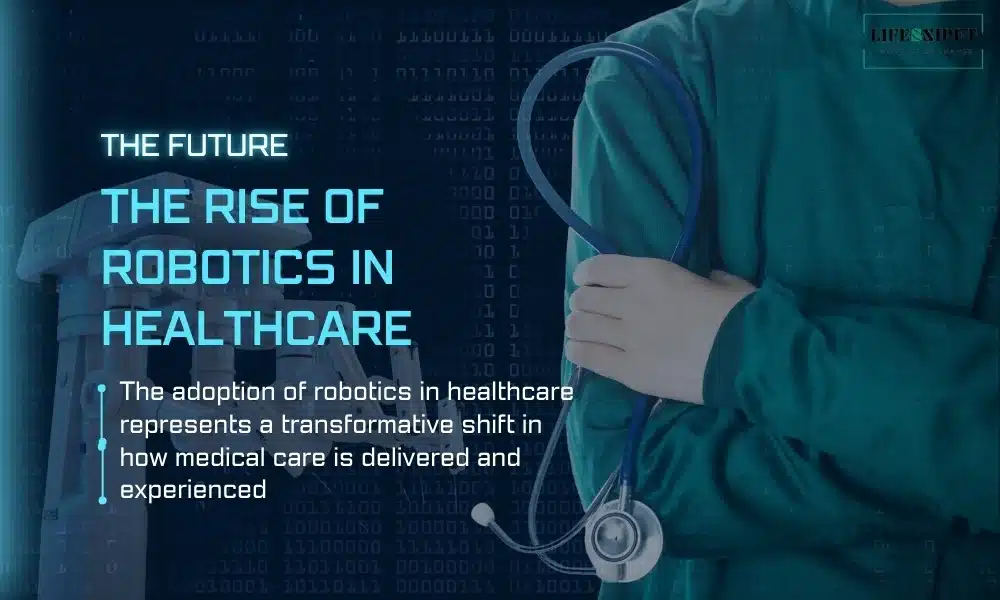The geography of healthcare is continuously evolving, driven by technological advancements that review the possibilities of opinion, treatment, and patient care. Among the transformative inventions, advanced robotics technology stands out as a game-changer, poised to revise healthcare assiduity in unknown ways.
In this blog, we’ll claw into the futuristic realm of healthcare exploring the multifaceted operations of advanced robotics and the profound impact it has on patient issues, medical procedures, and the overall healthcare geography.
Advanced Robotics Surgery: Precision Beyond Human Limits
One of the most revolutionary operations of advanced robotics in healthcare is robotic surgery. Imagine a script where surgical procedures are conducted with unequaled perfection, thanks to robotic systems guided by Generative artificial intelligence (GAI). Surgeons, equipped with advanced robotics tools, can perform minimally invasive surgeries with micro-level delicacy, significantly reducing recovery times and enhancing patient issues.
These robotic surgical systems, guided by AI algorithms, can dissect real-time data, acclimatize to unanticipated changes during surgery, and indeed unite with mortal surgeons to optimize decision-making. The integration of haptic feedback systems allows surgeons to feel and manipulate napkins ever, transcending the limitations of traditional surgery.
-
Enhanced Precision:
Robotic surgery achieves unequaled perfection compared to traditional styles. The robotic systems operate with high delicacy, allowing for intricate and delicate movements that surpass mortal capabilities.
-
Minimally Invasive Procedures:
Robotic surgery enables minimally invasive procedures, where surgeons use small lacerations. This results in reduced trauma to the case’s body, brisk recovery times, and minimized scarring.
-
Improved Visualization:
Advanced robotic systems give surgeons enhanced 3D visualization of the surgical point. This bettered visual clarity allows for better decision-making during procedures.
-
Artificial Intelligence Guidance:
Robotic surgical systems frequently integrate artificial intelligence algorithms. These AI factors dissect real-time data, conforming to unanticipated changes during surgery and uniting with mortal surgeons for optimal issues.
-
Haptic Feedback:
The incorporation of haptic feedback systems allows surgeons to feel and manipulate napkins. This tactile sensation enhances the surgeon’s sense of touch, contributing to the perfection of movements.
Nanorobotics for Targeted Drug Delivery
Imagine microscopic robots navigating the mortal body to deliver medicines with point delicacy. Nanorobotics, enabled by advanced robotics and nanotechnology, offers the eventuality for targeted medicine delivery at the cellular or indeed molecular position. These bitsy robots can navigate through the bloodstream, relating and treating specific cells or pathogens with unknown perfection.
The counteraccusations are profound — minimizing side goods, maximizing the remedial impact of specifics, and revolutionizing the treatment of conditions at their root. This position of perfection ensures that specifics reach their intended targets, sparing healthy napkins and reducing the overall burden on cases.
-
Microscopic Precision:
Nanorobotics involves microscopic robots, known as nanobots, to navigate the human body with extraordinary precision. These tiny machines can target specific cells or pathogens, delivering medications directly to the affected areas with unparalleled accuracy.
-
Targeted Drug Delivery:
One of the primary operations of nanorobotics is targeted medicine delivery. Nanobots can transport medicines to precise locales within the body, similar to excrescences or infected cells, ensuring that remedial agents reach their intended targets with minimum impact on healthy tissues.
-
Minimizing Side Effects:
Traditional Medicine delivery styles can lead to side goods as specifics circulate throughout the entire body. Nanorobotics minimizes these side goods by delivering medicines simply to the point of interest, reducing the threat of systemic responses and enhancing the overall safety profile of specifics.
-
Navigating Biological Barriers:
Nanorobots are designed to navigate through natural walls, similar to the bloodstream, effectively reaching locales that might be challenging for conventional medicine delivery styles. This capability opens up new possibilities for treating conditions at the cellular or molecular position.
-
Real-Time Monitoring:
Nanorobots equipped with detectors and imaging capabilities can give real-time monitoring of natural processes. This point allows healthcare professionals to track the effectiveness of medicine delivery, observe cellular responses, and make adaptations to treatment plans grounded on dynamic physiological conditions.
Nanorobotics for targeted medicine delivery represents a groundbreaking approach in drug, offering a position of perfection and customization that has the implicit to revise the treatment of colorful conditions.
Advanced Robotics Rehabilitation and Physical Therapy
Rehabilitation and physical remedy take on a futuristic dimension with the integration of advanced robotics. Picture a script where cases recovering from injuries or surgeries engage in substantiated recuperation programs eased by robotic exoskeletons and stoked reality interfaces. These robotic systems not only give physical support but also collect real-time data on cases’ movements, conforming the recuperation program in response to individual progress.
The community of robotics and artificial intelligence enables the creation of adaptive recuperation protocols that feed each case’s unique requirements. This substantiated approach accelerates recovery times, improves mobility, and enhances the overall effectiveness of recuperation sweats.
-
Exoskeleton Technology:
- Supported Mobility Robotic exoskeletons give individuals with supported mobility, abetting those with mobility impairments or recovering from injuries. These wearable biases support natural movements, helping cases recapture strength and collaboration.
- Targeted Muscle Engagement Exoskeleton-supported remedy allows for targeted engagement of specific muscle groups. This perfection contributes to further effective recuperation by fastening on areas that bear attention.
-
Virtual Reality Integration:
- Immersive Rehabilitation Integrating virtual reality into physical remedy introduces immersive surroundings that engage cases during exercises. VR-enhanced recuperation not only makes remedy more pleasurable but also stimulates neural pathways, abetting in motor skill recovery.
- Real-Time Feedback Virtual reality systems give real-time feedback on cases’ movements, allowing therapists to cover progress and make necessary adaptations to recuperation plans. This dynamic feedback circle enhances the effectiveness of remedial interventions.
-
Robot-Assisted Gait Training:
- Gait Pattern Correction Robot-supported gait training is necessary for correcting abnormal walking patterns. Cases recovering from neurological conditions or surgeries profit from repetitious, targeted gait training eased by robotic bias.
- Customizable Support Robotic gait training systems offer customizable situations of support, conforming to individual requirements. This rigidity allows for gradational progression as cases recapture strength and stability.
-
Smart Prosthetics and Orthotics:
- Responsive Mobility Incorporating robotics into prosthetics and orthotics results in responsive and adaptive mobility results. Smart prosthetic branches and orthotic bias use detectors and selectors to mimic natural movements, enhancing stoner comfort and functionality.
- Individualized Fit Robotic orthotics can be substantiated to match the specific biomechanics of an existent. This substantiated fit ensures optimal support and alignment, promoting effective recuperation.
-
Tele-Rehabilitation Services:
- Remote Availability Tele-recuperation leverages robotic technology to give physical remedies. Cases can pierce recuperation exercises and guidance from the comfort of their homes, promoting availability for those in remote areas or facing mobility challenges.
- Nonstop Monitoring Through telerehabilitation, therapists can ever cover cases’ progress using robotic bias. This nonstop monitoring enables timely adaptations to treatment plans, icing ongoing support and intervention.
- Robotic recuperation and physical remedy represent a transformative approach to recovery, using technology to enhance the perfection, engagement, and availability of recuperation services. As these advancements continue to evolve, the geography of recuperation is poised for further invention and bettered patient issues.
Telepresence Robots: Redefining Remote Healthcare
Physical distance becomes lower of a hedge to quality healthcare through the application of telepresence robots. These robots, equipped with advanced communication technologies and interactive interfaces, enable healthcare professionals to ever diagnose, cover, and engage with cases.
Imagine a script where a specialist half across the globe can nearly visit a case’s bedside, examine medical data in real-time, and indeed perform certain individual procedures through robotic incorporations. Telepresence robots not only ground geographical gaps but also grease timely interventions, particularly in extremities where immediate access to technical care is pivotal.
Robotic Prosthetics: Merging Man and Machine
Advanced robotics technology paves the way for the creation of largely sophisticated robotic prosthetics that seamlessly integrate with the mortal body. branch loss does not equate to a loss of functionality. Prosthetic branches, enhanced by robotics and AI, offer a position of dexterity and responsiveness that glasses natural movement.
Advanced robotics prosthetics can be controlled by neural interfaces, allowing druggies to execute intricate movements with perfection. The integration of sensitive feedback systems further blurs the lines between natural and artificial, furnishing druggies with a sense of touch and proprioception.
AI-Powered Robotic Diagnostics: From Symptom to Diagnosis
Imagine a healthcare system where advanced robotics, coupled with artificial intelligence, facilitates rapid-fire and accurate diagnostics. Cases present their symptoms to a robotic individual system, which employs sophisticated algorithms to dissect medical histories, inheritable data, and real-time physiological parameters. The result is a nippy and precise opinion that guides healthcare professionals in formulating acclimatized treatment plans.
This position of robotization not only expedites the individual process but also minimizes the threat of mortal error. AI-powered robotic diagnostics ensure that healthcare providers have access to a comprehensive understanding of each case’s health, leading to further effective and individualized care.
Robotic Companion Care for the Elderly
As the global population periods, the demand for senior care increases significantly robotic companion care emerges as a transformative result. Advanced robotics companions equipped with AI capabilities give emotional support, backing with diurnal tasks, and indeed medical monitoring for the senior.
These robotic companions, designed to understand and respond to mortal feelings, foster a sense of fellowship and reduce the passion of loneliness among seniors. They can remind druggies to take specifics, help with mobility, and indeed engage in discussion, enhancing the overall well-being of their mortal counterparts.
Automated Pharmacy Systems: Precision Medication Dispensing
Advanced robotics, integrated with AI algorithms, ensure precise lozenge computations, reducing the threat of drug crimes. These automated drugstore systems operate efficiently, streamlining the drug distribution process and minimizing delay times for cases.
Robotic drugstore sidekicks can manage force, track drug operation patterns, and induce real-time reports for healthcare providers. This position of robotization not only enhances patient safety but also optimizes the workflow within healthcare installations.
Conclusion:
Characterized by a renaissance fueled by advanced robotics technology. From robotic surgery to nanorobotics, and telepresence robots to automated drugstore systems, the integration of robotics and artificial intelligence transforms every hand of healthcare delivery. Case issues ameliorate, individual delicacy reaches unknown situations, and the boundaries of what’s medically attainable expand.
As we fantasize about this future, it’s pivotal to fete the ethical considerations and societal counteraccusations of embracing advanced robotics in healthcare. Striking a balance between technological invention and the preservation of mortal-centric care will be imperative. shaped by the flawless integration of robotics, paints a picture of a future where the possibilities are as measureless as the eventuality of invention.
FAQs
1. What is advanced robotics technology in healthcare?
Advanced robotics technology in healthcare refers to the use of sophisticated robotic systems, frequently integrated with artificial intelligence( AI), to enhance colorful aspects of medical care. This includes operations similar to robotic surgery, telepresence robots, robotic prosthetics, and more.
2. How does robotic surgery work, and what are its benefits?
Robotic surgery involves using robotic systems controlled by surgeons to perform precise and minimally invasive procedures. The benefits include enhanced perfection, shorter recovery times, reduced threat of complications, and the capability to perform complex surgeries with lower lacerations.
3. What are nanorobotics, and how is it used in healthcare?
Nanorobotics involves the use of bitsy robots( nanobots) to perform tasks at the cellular or molecular position. In healthcare, nanorobotics holds the eventuality for targeted medicine delivery, allowing specifics to be delivered to specific cells or pathogens with unknown perfection.
4. How do telepresence robots contribute to healthcare?
Telepresence robots enable healthcare professionals to ever diagnose, cover, and engage with cases. Equipped with advanced communication technologies, these robots grease virtual consultations, diagnostics, and indeed certain medical procedures, bridging geographical gaps and perfecting access to technical care.
5. What are the operations of robotic recuperation and physical remedy?
Robotic recuperation involves the use of robotic exoskeletons and interfaces in physical remedy programs. These systems give physical support, collect real-time movement data, and acclimatize recuperation protocols to individual progress, accelerating recovery and perfecting mobility.
6. How are AI-powered robotic diagnostics transubstantiating healthcare?
AI-powered robotic diagnostics dissect medical histories, inheritable data, and real-time physiological parameters to give rapid-fire and accurate judgments. This technology enhances the individual process, minimizes mortal error, and contributes to further effective and individualized treatment plans.
7. What part do advanced robotics prosthetics play in healthcare?
Robotic prosthetics seamlessly integrate with the mortal body, offering a high position of dexterity and responsiveness. Controlled by neural interfaces, these prosthetics give druggies a sense of touch and proprioception, revolutionizing the lives of individuals with branch loss.

Welcome to LifeSnipet! At LifeSnipet, we’re your ultimate source for the latest health updates. Specializing in health and fitness-related diseases, we delve deep into Ayurvedic techniques, providing you with a comprehensive understanding of well-being. Explore our real-time updates, detailed articles, and ancient Ayurvedic wisdom for a holistic approach to health. Embark on a journey to a healthier, vibrant life with LifeSnipet – where your well-being is our priority!











